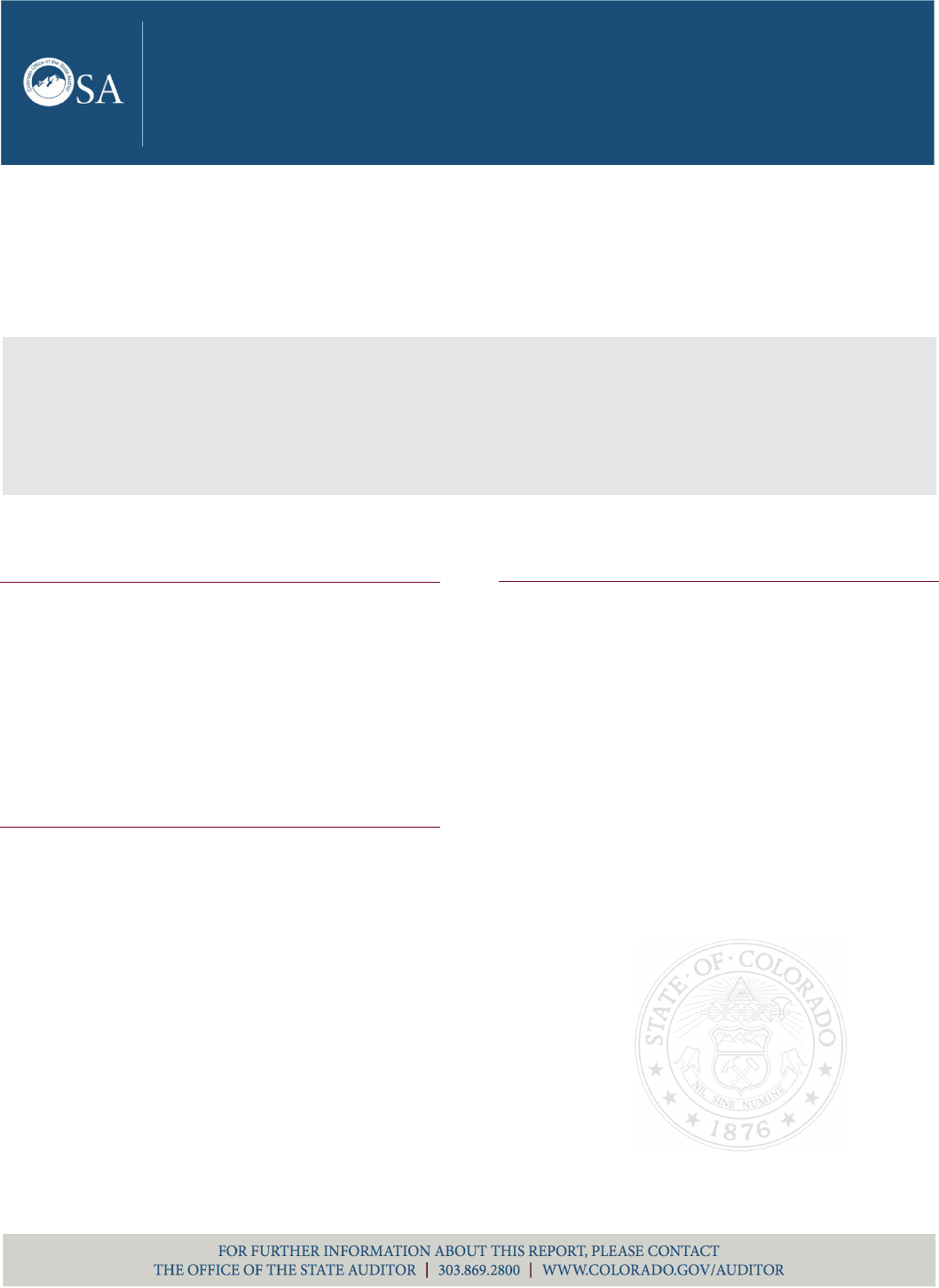
TAX TYPE Income
YEAR ENACTED 2000
REPEAL/EXPIRATION DATE None
REVENUE IMPACT $41.3 million
(TAX YEAR 2018)
NUMBER OF TAXPAYERS) 413,000
(TAX YEAR 2018)
WHAT DOES THE TAX EXPENDITURE
DO?
The Charitable Contribution Deduction [Section
39-22-104(4)(m), C.R.S.] allows an individual to
deduct the amount of any charitable contributions
over $500 from their state income, if the individual
claimed the standard deduction, instead of itemized
deductions, on their federal income tax return.
WHAT IS THE PURPOSE OF THE TAX
EXPENDITURE?
Statute and the enacting legislation for the
Charitable Contribution Deduction do not state its
purpose; therefore, we could not definitively
determine the General Assembly’s original intent.
However, based on how the deduction operates and
the bill sponsors’ legislative testimony, we
considered a potential purpose: to provide the
benefit of a deduction for charitable contributions
to taxpayers who claim the standard deduction on
their federal income tax return, similar to the
deduction benefit provided to taxpayers who
itemize their deductions on their federal return.
WHAT POLICY CONSIDERATIONS DID
THE EVALUATION IDENTIFY?
The General Assembly may want to consider:
Amending statute to establish a statutory
purpose and performance measures for the
deduction.
Reviewing the deduction’s $500 charitable
contribution floor.
Repealing an obsolete statutory reference to
taxpayers contributing to Hunger-Relief
organizations.
CHARITABLE CONTRIBUTION
DEDUCTION
EVALUATION SUMMARY | APRIL 2022 | 2022-TE18
KEY CONCLUSION: The deduction is effective at equalizing the state-level tax benefit provided to
taxpayers who make charitable contributions and claim the federal standard deduction with the
benefit provided to taxpayers who itemize their federal deductions. Its usage increased significantly
in Tax Year 2018 due to federal legislation, with higher income taxpayers claiming the deduction
more frequently.

2
CHARITABLE CONTRIBUTION DEDUCTION
CHARITABLE
CONTRIBUTION
DEDUCTION
EVALUATION RESULTS
WHAT IS THE TAX EXPENDITURE?
The Charitable Contribution Deduction [Section 39-22-104(4)(m),
C.R.S.] allows an individual to deduct the amount of any charitable
contributions over $500 from their state taxable income, if the
individual claimed the standard federal deduction instead of itemizing
deductions on their federal income tax return. For example, if an
individual makes $1,300 in charitable contributions during the year and
claims the federal standard deduction, they would be allowed to deduct
$800 when calculating their state taxable income. The deduction must
be used in the tax year when the individual makes the contributions,
and if its value exceeds income tax owed, it cannot be carried forward
to future years.
Since 1987, Federal Taxable Income (FTI), which is Adjusted Gross
Income (AGI) minus either itemized deductions or the standard
deduction, has served as the starting point for calculating Colorado
taxable income. Federal law allows taxpayers to deduct charitable
contributions from their AGI, which would also reduce their Colorado
taxable income. However, taxpayers must itemize their federal
deductions to claim a federal charitable contribution deduction. The
State’s Charitable Contribution Deduction allows taxpayers who use
the standard deduction to claim a state-level deduction for charitable
contributions. EXHIBIT 1 shows how taxpayers claim federal and state
deductions for charitable contributions based on whether they itemize
their deductions or claim the standard deduction on their federal tax
return.
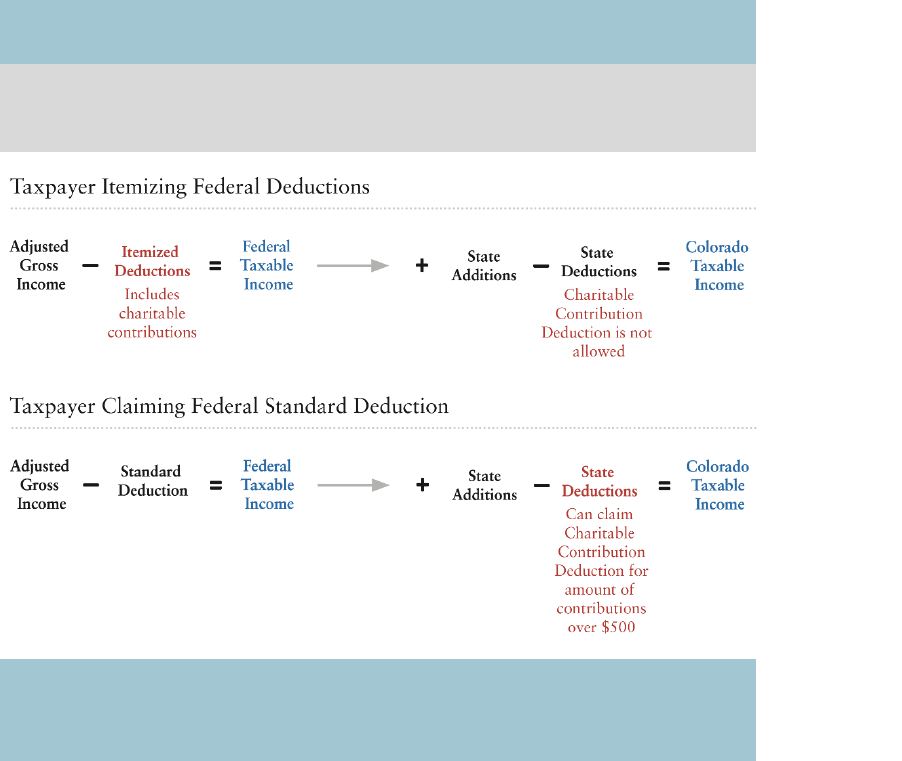
3
TAX EXPENDITURES REPORT
EXHIBIT 1. CHARITABLE CONTRIBUTION DEDUCTIONS
FOR FEDERAL AND STATE INCOME TAXES
Taxpayers itemizing deductions subtract charitable contributions before arriving at
federal taxable income, while taxpayers claiming the standard deduction only
subtract charitable contributions before arriving at Colorado taxable income.
SOURCE: Office of the State Auditor description of the calculation of net Colorado
taxable income when a taxpayer claims their charitable contribution either as an
itemized deduction when calculating federal taxable income, or as a state deduction
when calculating state taxable income.
In order to qualify for the state Charitable Contribution Deduction,
taxpayers must:
Be a person who can claim the federal standard deduction under
Internal Revenue Code 26 USC 63. Individuals claimed as
dependents on another return; spouses filing separately if either
spouse itemizes deductions; non-resident aliens; and fiduciaries,
partnerships, or corporations do not qualify.
Claim the federal standard deduction when filing their income tax
return.

4
CHARITABLE CONTRIBUTION DEDUCTION
Make charitable contributions that would qualify for the federal
charitable contribution deduction under Internal Revenue Code 26
USC 170. Contributions can include both cash and non-cash
contributions (e.g., stock and tangible property).
While statute does not specify a cap on the amount of contributions that
can be deducted, Department of Revenue (Department) regulations
indicate that the federal charitable contribution deduction limitations
set forth in 26 USC 170 also apply to the state deduction [1 CCR 201-
2 Rule 39-22-104(4)(m)(2)]. These limitations restrict the amount a
taxpayer can deduct to a maximum percentage of the taxpayer’s AGI,
which varies between 20 and 60 percent of AGI based on the type of
organization that the taxpayer contributes to, and the type of
contribution (i.e., cash or non-cash). For example, taxpayers making a
cash contribution to public charities can claim a deduction of up to 60
percent of their AGI; however, deductions based on cash contributions
to veterans’ organizations or fraternal societies are limited to 30 percent
of the taxpayer’s AGI.
Taxpayers claim the Charitable Contribution Deduction on Line 9 of
the state Subtraction from Income Schedule (Form DR 0104AD), which
they must attach to their Colorado Income Tax Return. Taxpayers enter
the total amount of their contribution and then subtract from their state
taxable income the contribution amount that is over $500.
The General Assembly originally created the Charitable Contribution
Deduction as a Taxpayer’s Bill of Rights (TABOR) refund mechanism
in 2000 (House Bill 00-1053). In 2010, Senate Bill 10-212 repealed
several TABOR refund mechanisms, including the Charitable
Contribution Deduction, and made the deduction permanent and
available in all years (i.e., taxpayers can claim the deduction even when
there is not a TABOR surplus).
While the State has not substantially changed the deduction since 2010,
two major federal changes have had an impact on the number of
taxpayers that claim the standard deduction, and are therefore eligible

5
TAX EXPENDITURES REPORT
for the state deduction, and the total deduction a taxpayer can claim.
First, in 2017, the U.S. Congress passed the Tax Cuts and Jobs Act
(TCJA), which nearly doubled the amount of the standard deduction
through 2025. For example, prior to 2018, the standard deduction for
an individual was $6,500; for Tax Years 2018 through 2025, the
standard deduction increased to $12,000, adjusted annually for
inflation. The TCJA also limited the amount of itemized deductions that
taxpayers could claim for other expenses, including mortgage interest
and state and local taxes paid. In addition to increasing the standard
deduction, the TCJA also temporarily raised the limit on the amount of
charitable contribution deductions that a taxpayer can claim.
Specifically, for Tax Years 2018 through 2025, the charitable
contribution deduction limitation was modified from 50 percent of AGI
to 60 percent.
Second, in response to the COVID-19 pandemic, Congress passed bills
that modified the AGI limitations for charitable contribution
deductions and created a temporary charitable contribution deduction
for individuals that make cash contributions, but claim the standard
deduction on their federal income tax return:
In 2020, the Coronavirus Aid, Relief, and Economic Security
(CARES) Act created a 1-year charitable contribution deduction of
up to $300 for individuals who make a cash contribution and claim
the standard deduction. The CARES Act also temporarily raised the
limit for cash contributions from 60 percent to 100 percent of AGI.
In 2020, the Consolidated Appropriations Act (CAA) extended the
charitable contribution deduction for taxpayers making cash
donations and claiming the standard deduction through 2021. The
maximum amount remained at $300 for individual filers, but
married taxpayers filing jointly could deduct up to $600. The CAA
also extended the CARES Act provision raising the limit for cash
contributions to 100 percent of AGI, through 2021.

6
CHARITABLE CONTRIBUTION DEDUCTION
WHO ARE THE INTENDED BENEFICIARIES OF THE TAX
EXPENDITURE?
Statute does not explicitly state the intended beneficiaries of the
Charitable Contribution Deduction. However, based on its operation,
and testimony from hearings related to the enacting legislation (House
Bill 00-1053), we inferred that the intended direct beneficiaries are
taxpayers who contribute more than $500 to charities, but claim the
standard deduction.
Bill sponsors stated that they intended that the deduction would mainly
benefit low- and middle-income taxpayers, who were more likely than
higher-income taxpayers to claim the federal standard deduction
because their itemizable expenses (e.g., charitable contributions,
mortgage interest, medical expenses, and state and local taxes paid)
generally do not exceed the standard deduction. Additionally, they
indicated that the bill would benefit a smaller number of taxpayers who
may have a high income or high net worth, but who do not have
itemizable expenses that exceed the standard deduction (e.g., retirees
who do not have mortgage payments or significant medical expenses).
However, changes under the TCJA have impacted the number and
income level of Colorado taxpayers who can potentially benefit from
the deduction. Specifically, the standard deduction had only been
annually adjusted for inflation since the 1970s through Tax Year 2017,
until the TCJA roughly doubled the standard deduction for Tax Years
2018 through 2025, from $6,500 to $12,000 for single filers and from
$13,000 to $24,000 for married couples filing jointly. This change
significantly increased the number of Coloradans claiming the federal
standard deduction, and who could therefore claim the State’s
Charitable Contribution Deduction, at all income levels. Specifically,
for Tax Years 2015 through 2017, about 66 percent of Colorado
taxpayers’ returns claimed the standard deduction on their federal
returns. Then in Tax Year 2018, the first year of the temporary increase
in the standard deduction under the TCJA, the proportion of Colorado
returns claiming the standard deduction increased to 86 percent.
Further, the change in the proportion of taxpayers who claimed the
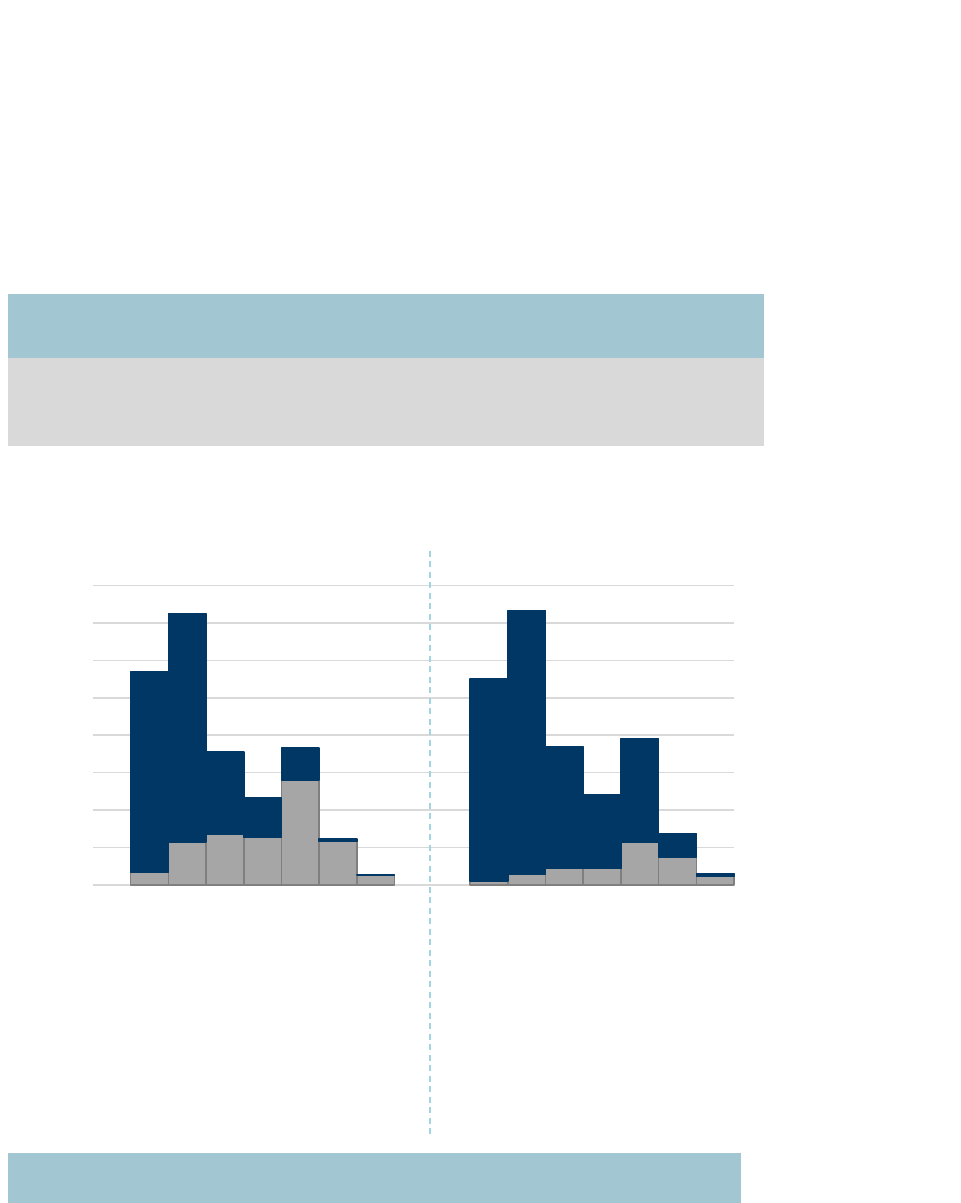
7
TAX EXPENDITURES REPORT
Itemized Deduction
Standard Deduction
2017
2018
standard deduction was the most significant among taxpayers with
AGIs over $75,000. For example, prior to the TCJA about 27 percent
of taxpayers with AGI’s between $75,000 and $499,000 claimed the
standard deduction; whereas, in Tax Year 2018, after the passage of the
TCJA, 70 percent of these taxpayers claimed it. EXHIBIT 2 shows the
increase in standard deduction filers in Colorado across income levels
from Tax Year 2017 to 2018.
EXHIBIT 2. INCREASE IN RETURNS CLAIMING
THE STANDARD DEDUCTION, BY AGI
Due to temporary increases in the federal standard deduction under the TCJA there
was a large shift of returns claiming the standard deduction instead of itemizing
between Tax Years 2017 and 2018.
SOURCE: Office of the State Auditor analysis of Department of Revenue Statistics of Income
for Tax Years 2017 through 2018.
0
100,000
200,000
300,000
400,000
500,000
600,000
700,000
800,000
$ 0 to $ 19,999
$ 20,000 to $ 49,999
$50,000 to $74,999
$ 75,000 to $ 99,999
$ 100,000 to $ 199,999
$ 200,000 to $ 499,999
$ 500,000 and over
$ 0 to $ 19,999
$ 20,000 to $ 49,999
$50,000 to $74,999
$ 75,000 to $ 99,999
$ 100,000 to $ 199,999
$ 200,000 to $ 499,999
$ 500,000 and over
2017 2018
TCJA Takes Effect

8
CHARITABLE CONTRIBUTION DEDUCTION
In addition to benefiting taxpayers who claim the Charitable
Contribution Deduction, bill sponsors stated that the deduction may
incentivize taxpayers who claim the standard deduction to make or
increase their charitable contributions, thereby benefitting charitable
organizations. Therefore, we inferred that the indirect beneficiaries of
the deduction include the charities that receive the contributions, and
the greater community that is served by charitable organizations
receiving contributions.
WHAT IS THE PURPOSE OF THE TAX EXPENDITURE?
Statute and the enacting legislation for the Charitable Contribution
Deduction do not state its purpose; therefore, we could not definitively
determine the General Assembly’s original intent. However, based on
how the deduction operates and the bill sponsors’ legislative testimony,
we considered a potential purpose: to provide the benefit of a deduction
for charitable contributions to taxpayers who claim the standard
deduction, similar to the benefit provided to taxpayers who itemize their
deductions. Specifically, because federal taxable income is the starting
point for calculating state taxable income, the bill sponsors for the
deduction testified that taxpayers who make charitable contributions
and itemize their deductions receive a state tax benefit that taxpayers
who claim the standard deduction do not receive. The bill sponsors
stated that the bill would “remedy an inequity in the law by extending
the same benefit to non-itemizing taxpayers that give charitable
contributions that is currently enjoyed by itemizing taxpayers.” The
threshold for the benefit was set at $500 because the bill sponsors
believed that the standard deduction already assumes $500 of charitable
contributions in its calculation, therefore setting a floor for that amount
would prevent a taxpayer from receiving a “double benefit.”
IS THE TAX EXPENDITURE MEETING ITS PURPOSE AND
WHAT PERFORMANCE MEASURES WERE USED TO MAKE
THIS DETERMINATION?
We could not definitively determine if the Charitable Contribution
Deduction is meeting its purpose because statute and the enacting

9
TAX EXPENDITURES REPORT
legislation do not provide a purpose. However, we found that it is likely
meeting the purpose we considered for this evaluation because it is
commonly used by taxpayers who make charitable contributions and
claim the standard deduction, allowing them to claim a similar benefit
as those who make charitable contributions and itemize their
deductions.
PERFORMANCE MEASURE:
To what extent is the deduction used by
eligible taxpayers?
RESULT: Overall, we found that the deduction is commonly claimed by
taxpayers in Colorado, with about 152,000 returns claiming it in Tax
Year 2017, increasing to about 350,000 in Tax Year 2018, following
the passage of the TCJA.
Although the deduction is widely used, we lacked data necessary to
determine the proportion of eligible taxpayers who claimed the
deduction. However, about 17 percent of the 2.1 million Colorado tax
returns that claimed the standard deduction in Tax Year 2018 claimed
the Charitable Contribution Deduction, which is up from about 10
percent in Tax Year 2017. In comparison, about 50 percent of all U.S.
households made charitable contributions of some amount in 2018,
including households that itemize deductions, with an average
contribution amount of about $1,300, according to research conducted
by the University of Indiana, Lilly School of Philanthropy. Therefore, if
charitable giving among Colorado standard deduction filers is similar
to that of the United States as a whole, it appears that some eligible
taxpayers may not have claimed the deduction. It is possible that this is
due to a lack of awareness of the deduction, taxpayers making
contributions that do not exceed the $500 floor, or because it provides
a relatively small tax benefit to taxpayers with contribution amounts
that do not substantially exceed $500. For example, a taxpayer with
$750 in eligible contributions would see a reduction in tax liability from
the deduction of about $11 dollars. Therefore, some taxpayers may not
be motivated to keep a record of their charitable giving in order to claim
the deduction, if they do not anticipate significant tax savings.

10
CHARITABLE CONTRIBUTION DEDUCTION
Furthermore, some taxpayers may lack sufficient taxable income to be
able to benefit from the deduction. For example, taxpayers who are
married and filing jointly and who have a gross income of about
$24,000 would have no federal taxable income after deducting the
standard deduction and therefore, would not be able to receive a benefit
from the Charitable Contribution Deduction.
WHAT ARE THE ECONOMIC COSTS AND BENEFITS OF THE
TAX EXPENDITURE?
Between Tax Years 2015 and 2017, the revenue impact of the
Charitable Contribution Deduction was an average of $12.2 million
annually. In Tax Year 2018, when the TCJA changes nearly doubled
the federal standard deduction, many taxpayers who had been itemizing
and claiming the federal charitable contribution deduction, shifted to
claiming the federal standard deduction and were then able to claim the
state Charitable Contribution Deduction instead. Because of this shift,
there was a decrease in the amount claimed by Colorado taxpayers on
their federal income tax return for itemized charitable contributions,
but an increase in the revenue impact to the State for the Charitable
Contribution Deduction. Specifically, the amount claimed by taxpayers
for itemized charitable contributions on their federal income tax return
dropped about $55.3 million, from $223.5 million in Tax Year 2017 to
$168.2 million in Tax Year 2018, while the revenue impact to the State
for the Charitable Contribution Deduction increased by about $29.9
million, from $11.4 million in Tax Year 2017 to $41.3 million in Tax
Year 2018. However, for taxpayers who switched to claiming the
federal standard deduction and then the state Charitable Contribution
Deduction, their charitable contribution deductions were reduced by
$500 due to the Charitable Contribution Deduction’s $500 floor.
In addition, economic research indicates that tax benefits can encourage
individuals to make charitable contributions by lowering the net cost of
the contribution. Therefore, to the extent that the Charitable
Contribution Deduction encourages taxpayers to make charitable
contributions, it also provides a benefit to the organizations that receive

11
TAX EXPENDITURES REPORT
the contributions. However, because the Charitable Contribution
Deduction provides a relatively small reduction in tax liability, its
impact on donation amounts is also likely small. Specifically, because it
is structured as a deduction, the benefit it provides taxpayers is
equivalent to the deduction amount multiplied by the state income tax
rate (4.55 percent). Further, because the deduction excludes the first
$500 in contributions and is limited to, at most 60 percent of taxpayers’
AGI, taxpayers cannot deduct the full value of their contributions.
Based on Department data, we found that between Tax Years 2015
through 2018, taxpayers who claimed the deduction received a
reduction in tax liability equivalent to between 3.1 and 3.5 percent of
their charitable contributions for the year. Exhibit 3 shows the
reduction in tax liability as a portion of contribution amounts for
taxpayers who claimed the deduction.
EXHIBIT 3. TOTAL CONTRIBUTIONS
AND REDUCTION IN TAX LIABILITY
For Tax Years 2015 through 2018, taxpayers reduced their tax liability
by a small percentage of their total contributions.
SOURCE: Office of the State Auditor analysis of Department of Revenue tax data
for the Charitable Contribution Deduction for Tax Years 2015 to 2018.
3.1% 3.2% 3.5%
3.5%
$-
$100,000,000
$200,000,000
$300,000,000
$400,000,000
$500,000,000
$600,000,000
$700,000,000
$800,000,000
$900,000,000
$1,000,000,000
$1,100,000,000
$1,200,000,000
2015 2016 2017 2018
Reduction in tax liability
Charitable contributions
2018 TCJA
Takes Effect

12
CHARITABLE CONTRIBUTION DEDUCTION
Additionally, research from the Congressional Research Service, the
Indiana University Lilly School of Philanthropy, the American Institute
of Certified Professional Accountants (AICPA), and other
organizations, finds that the driving factors for charitable contributions
include believing in an organization’s mission, having a personal
connection to the cause or organization, a desire to contribute to the
community, religious beliefs, and other non-financial incentives.
Further, a Colorado Non-Profit Association survey of Colorado donors
from 2014 found that only 38 percent of respondents said that tax
benefits are a “very or somewhat important reason for giving,”
suggesting that most donors would have donated regardless of the
deduction.
However, stakeholders we spoke with also reported that while people
often make a decision to contribute to charity based on these non-
financial incentives, they often increase their contributions, including
giving more at the end of the tax year, in order to benefit from a tax
deduction. Further, charitable organizations often use the availability of
a deduction as a marketing tool to encourage donations and reported
that the presence of a deduction, regardless of the level of financial
benefit to the taxpayer, can have a positive impact on charitable
contributions because it shows that philanthropic behavior is valued.
Therefore, the deduction may increase charitable giving in the state to
some extent. However, this economic impact likely is not confined to
Colorado because taxpayers are not required to contribute to Colorado-
based organizations. We did not have access to data on which
nonprofits received these contributions and therefore, we could not
estimate the economic benefit that was specific to Colorado.
We also evaluated the extent to which the deduction benefits taxpayers
across income levels and found that the TCJA’s changes to the standard
deduction in Tax Year 2018 caused more higher-income taxpayers to
claim the standard deduction and also the Charitable Contribution
Deduction. Specifically, in Tax Year 2017, taxpayer returns with an
AGI of less than $75,000 made up 87 percent of returns claiming the
standard deduction and 65 percent of returns claiming the Charitable
Contribution Deduction. However, in 2018, taxpayer returns with an
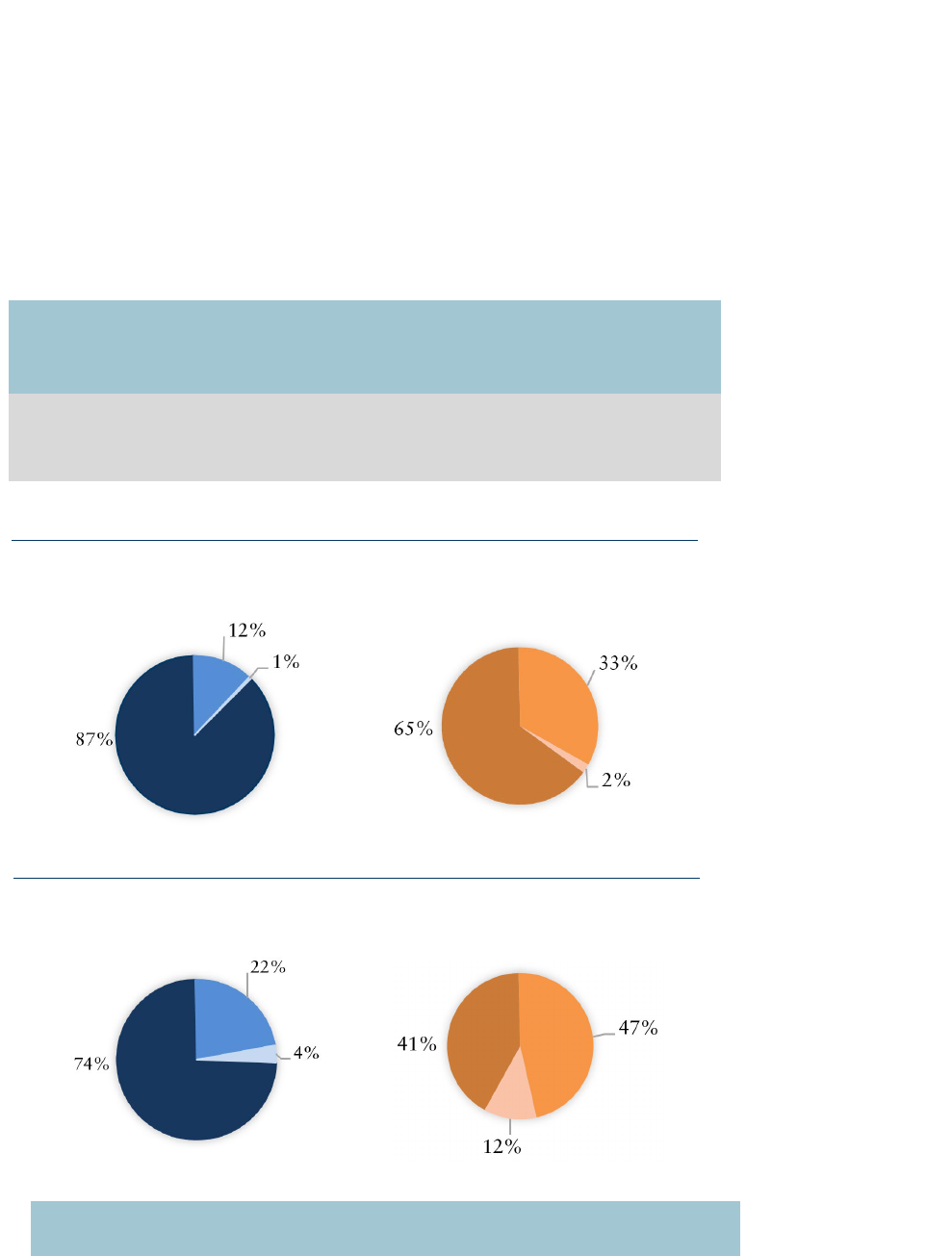
13
TAX EXPENDITURES REPORT
AGI of less than $75,000 decreased to 74 percent of returns claiming
the standard deduction, and 41 percent of returns claiming the
Charitable Contribution Deduction. Therefore, while the deduction
continues to benefit taxpayers with low and middle incomes, it also
benefits a larger proportion of taxpayers with higher incomes. EXHIBIT
4 shows the shift in income levels for taxpayers claiming the standard
deduction and Charitable Contribution Deduction between Tax Year
2017 and 2018.
EXHIBIT 4. INCREASE IN RETURNS CLAIMING
THE STANDARD DEDUCTION AND CHARITABLE
CONTRIBUTION DEDUCTION, BY AGI
Due to temporary increases in the federal standard deduction under the TCJA there
was a large shift in higher income taxpayers claiming the standard deduction and the
Charitable Contribution Deduction between Tax Years 2017 and 2018.
AGI < $75,000
AGI $75,000 to
$199,000
AGI >= $200,000
AGI < $75,000
AGI $75,000 to
$199,000
AGI >= $200,000
Standard Deduction
Returns by Income
Charitable Contribution
Returns by Income
TAX YEAR 2017
TAX YEAR 2018
Standard Deduction
Returns by Income
Charitable Contribution
Returns by Income
SOURCE: Office of the State Auditor analysis of Department of Revenue Statistics
of Income for Tax Years 2017 through 2018.

14
CHARITABLE CONTRIBUTION DEDUCTION
WHAT IMPACT WOULD ELIMINATING THE TAX
EXPENDITURE HAVE ON BENEFICIARIES?
If the deduction was eliminated, taxpayers who claim the federal
standard deduction and make charitable contributions would no longer
receive a state tax benefit for their contributions. The specific benefit is
unique to each taxpayers’ contribution amount and income taxes owed.
For example, if a hypothetical taxpayer with a charitable contribution
of $2,000 itemizes their deductions on their federal tax return, they can
deduct the full $2,000 from their federal taxable income. Since federal
taxable income is the starting point for calculating state taxable income,
the taxpayer would receive a corresponding state tax benefit of about
$91. If the taxpayer claims the federal standard deduction, they would
be able to deduct up to $1,500 from their state taxable income, and
would receive a tax benefit of about $68. However, if the Charitable
Contribution Deduction was eliminated, the taxpayer claiming the
standard deduction and making charitable contributions would no
longer receive that tax benefit.
According to Department data, for Tax Year 2018, the median
Charitable Contribution Deduction was $1,290. Therefore, if the
deduction was repealed, assuming taxpayers still make the same
contributions, taxpayers who make the median contribution amount
would owe about $59 more in income taxes. However, some taxpayers
could see a more significant impact if their deductions are above the
median. For example, while less than 3 percent of Tax Year 2018
returns claimed a deduction that exceeded $10,000, this deduction
amount currently provides a tax benefit of over $455, which would no
longer be available.
Additionally, because contribution amounts tend to increase as
taxpayers’ AGI increases, the monetary impact of repealing
the expenditure increases as AGI increases. EXHIBIT 5 shows that for
Tax Year 2018, average tax benefits for each AGI level ranged from
about $70 to $180, with taxpayers at the highest AGI level receiving
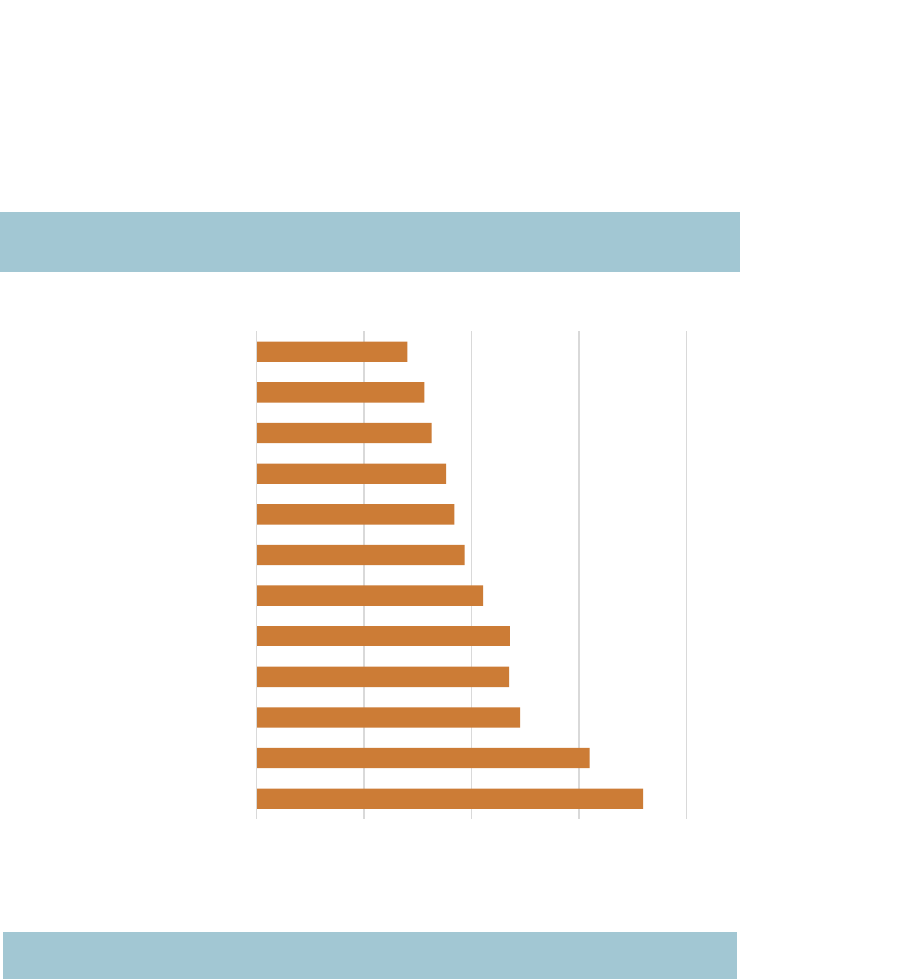
15
TAX EXPENDITURES REPORT
the largest tax benefit, which would no longer be available if the
deduction was repealed. However, taxpayers with lower- and middle-
income AGIs would be more impacted by a repeal of the deduction, as
a proportion of their income.
EXHIBIT 5. AVERAGE TAX BENEFIT BY TAXPAYER AGI,
TAX YEAR 2018
SOURCE: Office of the State Auditor analysis of Department of Revenue data for returns
claiming the Charitable Contribution deduction for Tax Year 2018.
In addition to increasing the tax liability of taxpayers who currently
claim the deduction, because the deduction may incentivize some
taxpayers to make charitable contributions, charitable organizations
may experience a decrease in donations if the deduction was no longer
available. As discussed, stakeholders indicated that the deduction
encourages taxpayers to make contributions, in particular, providing
$70
$180
$- $50 $100 $150 $200
$ 0 to $ 9,999
$ 10,000 to $ 19,999
$ 20,000 to $ 29,999
$ 30,000 to $ 39,999
$ 40,000 to $ 49,999
$ 50,000 to $ 59,999
$ 60,000 to $ 74,999
$ 75,000 to $ 99,999
$ 100,000 to $ 199,999
$ 200,000 to $ 499,999
$ 500,000 to $ 999,999
$ 1,000,000 and over
Average Tax Benefit
Adjusted Gross Income (AGI)

16
CHARITABLE CONTRIBUTION DEDUCTION
them with an incentive to make larger contributions due to their tax
advantaged status. Further, due to the TCJA, many higher income
taxpayers can no longer benefit at the federal level by claiming an
itemized deduction for their charitable contributions, meaning that the
State’s Charitable Contribution Deduction is the only tax benefit
available for most taxpayers who make contributions. However,
because the typical reduction in tax liability provided by the deduction
is equivalent to about 3.1 to 3.5 percent of the contribution amount, it
may not currently be providing a strong incentive to make charitable
contributions and so the impact to charitable organizations may be
limited. Further, because taxpayers who make very large charitable
contributions, for example those over $30,000, would likely still benefit
from itemizing their federal tax deductions, they would continue to have
incentives at both the federal and state level for making charitable
contributions.
Finally, stakeholders reported that they often rely on the contributions
and deductions the Department reports to understand charitable giving
in Colorado. If the Charitable Contribution Deduction were repealed,
the Department, and therefore stakeholders, would no longer have this
information.
ARE THERE SIMILAR TAX EXPENDITURES IN OTHER STATES?
There are four states (Idaho, North Dakota, Oregon, and South
Carolina), other than Colorado, that base their state taxable income off
of FTI, and therefore, include either itemized deductions or the standard
deduction amount when determining the starting amount of taxable
income. Three of these states (Idaho, Oregon, and South Carolina) offer
taxpayers a charitable contribution deduction, however, these states
differ from Colorado because they do not specify that the deduction is
only for taxpayers who claim the federal standard deduction and they
offer deductions for charitable contributions to specific industries or
organizations located within their states.

17
TAX EXPENDITURES REPORT
ARE THERE OTHER TAX EXPENDITURES OR PROGRAMS
WITH A SIMILAR PURPOSE AVAILABLE IN THE STATE?
As discussed, taxpayers who make charitable contributions and itemize
their federal deductions can claim a federal deduction for charitable
contributions under Internal Revenue Code 26 USC 170. The federal
deduction is limited to between 20 and 60 percent of a taxpayer’s
adjusted gross income depending on the type of organizations they
contribute to and the type of contributions (i.e., cash versus non-cash).
Because Colorado uses federal taxable income as the starting point for
Colorado taxable income, taxpayers who claim the federal deduction
automatically receive a benefit for state tax purposes. However, in
2021, the Generally Assembly passed House Bill 21-1311, which
capped the amount of charitable contributions high-income taxpayers
can deduct. Specifically, beginning in 2022, taxpayers with an AGI of
$400,000 or more must add back itemized deductions that exceed the
cap ($30,000 for single filers and $60,000 for joint filers) to their
Colorado taxable income.
WHAT DATA CONSTRAINTS IMPACTED OUR ABILITY TO
EVALUATE THE TAX EXPENDITURE?
We did not encounter any data constraints that impacted our ability to
evaluate the deduction.
WHAT POLICY CONSIDERATIONS DID THE EVALUATION
IDENTIFY?
THE GENERAL ASSEMBLY MAY WANT TO CONSIDER AMENDING STATUTE
TO ESTABLISH A STATUTORY PURPOSE AND PERFORMANCE MEASURES FOR
THE
CHARITABLE CONTRIBUTION DEDUCTION. As discussed, statute and
the enacting legislation for the deduction do not state its purpose or
provide performance measures for evaluating its effectiveness.
Therefore, for the purposes of our evaluation, we considered a potential
purpose for the deduction: to provide the benefit of a deduction on
charitable contributions for taxpayers who claim the standard
deduction, similar to the deduction benefit provided to taxpayers who
itemize their deductions. We identified this purpose based on how the

18
CHARITABLE CONTRIBUTION DEDUCTION
deduction operates and bill sponsor testimony from hearings for the
enacting legislation (House Bill 00-1053). We also developed a
performance measure to assess the extent to which the deduction is
meeting this potential purpose. However, the General Assembly may
want to clarify its intent for the deduction by providing a purpose
statement and corresponding performance measure(s) in statute. This
would eliminate potential uncertainty regarding the deduction’s
purpose and allow our office to more definitively assess the extent to
which the deduction is accomplishing its intended goal(s).
THE GENERAL ASSEMBLY MAY WANT TO REVIEW THE DEDUCTION’S $500
CHARITABLE CONTRIBUTION
FLOOR. Based on our review of committee
testimony at the time the deduction was created, bill sponsors included
the requirement that taxpayers can only deduct charitable contributions
that are over $500 because they believed that the federal standard
deduction was already structured to include about $500 of charitable
giving, and therefore, this “floor” would prevent a taxpayer from
receiving a double benefit (i.e., effectively receiving $500 of the standard
deduction based on charitable giving, and then deducting this amount
again from state taxable income by claiming the Charitable
Contribution Deduction). However, based on our review of academic
and economic publications regarding the basis of the standard
deduction amount, it is not clear that the standard deduction amount
was structured to include charitable giving, or, if it was, that $500
represents typical giving for taxpayers claiming the standard deduction.
Specifically, while some sources indicate that the standard deduction is
meant to simplify tax filing by providing a deduction amount that is
equivalent to itemized deductions that would be available to the typical
taxpayer, others indicate that it is meant to provide a more progressive
tax system by establishing a base of untaxed income. Additionally, since
2000, when the Charitable Contribution Deduction was established, the
standard deduction amount has increased substantially due to both
adjustments for inflation and changes under the TCJA, however the
$500 floor has not been modified. Specifically, the standard deduction
for single filers increased from $4,400 in Tax Year 2000 to $12,550 in
Tax Year 2021. Further, a review of Congressional testimony for the

19
TAX EXPENDITURES REPORT
TCJA did not indicate whether or not the standard deduction amounts
that were established were intended to account for itemizable expenses.
Therefore, the General Assembly may wish to review the $500 floor to
determine whether it continues to meet its intent for the deduction.
Generally, increasing the floor to account for significant changes to the
standard deduction would reduce the benefit provided to taxpayers and,
therefore, reduce the revenue impact to the State. On the other hand,
decreasing or eliminating the floor would make the deduction available
to taxpayers who make smaller contributions, which tends to include
lower income taxpayers; increase the revenue impact to the State; and
may better align the deduction with the view of the standard deduction
as a mechanism to make the federal tax code more progressive.
THE GENERAL ASSEMBLY MAY WANT TO CONSIDER REPEALING AN
OBSOLETE STATUTORY REFERENCE TO TAXPAYERS CONTRIBUTING TO
HUNGER
-RELIEF ORGANIZATIONS. Statute [Section 39-22-
104(4)(m)(VII), C.R.S.] states that a taxpayer cannot claim the
Charitable Contribution Deduction for contributions for which they
also claim the Food Contributions to Hunger-Relief Charitable
Organizations Credit. This credit expired January 1, 2020, so the
General Assembly may want to consider repealing this provision.
